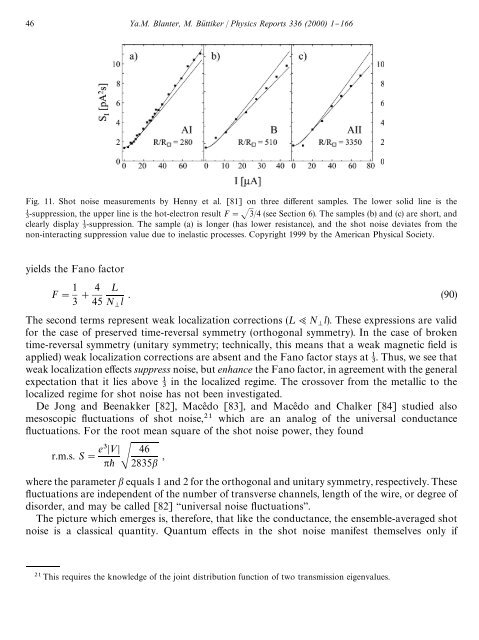shot noise in mesoscopic conductors - Low Temperature Laboratory
shot noise in mesoscopic conductors - Low Temperature Laboratory
shot noise in mesoscopic conductors - Low Temperature Laboratory
You also want an ePaper? Increase the reach of your titles
YUMPU automatically turns print PDFs into web optimized ePapers that Google loves.
46 Ya.M. Blanter, M. Bu( ttiker / Physics Reports 336 (2000) 1}166<br />
Fig. 11. Shot <strong>noise</strong> measurements by Henny et al. [81] on three di!erent samples. The lower solid l<strong>in</strong>e is the<br />
-suppression,<br />
the upper l<strong>in</strong>e is the hot-electron result F"3/4 (see Section 6). The samples (b) and (c) are short, and<br />
<br />
clearly display -suppression. The sample (a) is longer (has lower resistance), and the <strong>shot</strong> <strong>noise</strong> deviates from the<br />
<br />
non-<strong>in</strong>teract<strong>in</strong>g suppression value due to <strong>in</strong>elastic processes. Copyright 1999 by the American Physical Society.<br />
yields the Fano factor<br />
F" 1 4 ¸<br />
# . (90)<br />
3 45 N l<br />
<br />
The second terms represent weak localization corrections (¸;N l). These expressions are valid<br />
<br />
for the case of preserved time-reversal symmetry (orthogonal symmetry). In the case of broken<br />
time-reversal symmetry (unitary symmetry; technically, this means that a weak magnetic "eld is<br />
applied) weak localization corrections are absent and the Fano factor stays at . Thus, we see that<br />
<br />
weak localization e!ects suppress <strong>noise</strong>, but enhance the Fano factor, <strong>in</strong> agreement with the general<br />
expectation that it lies above <strong>in</strong> the localized regime. The crossover from the metallic to the<br />
<br />
localized regime for <strong>shot</strong> <strong>noise</strong> has not been <strong>in</strong>vestigated.<br />
De Jong and Beenakker [82], Mace( do [83], and Mace( do and Chalker [84] studied also<br />
<strong>mesoscopic</strong> #uctuations of <strong>shot</strong> <strong>noise</strong>, which are an analog of the universal conductance<br />
#uctuations. For the root mean square of the <strong>shot</strong> <strong>noise</strong> power, they found<br />
r.m.s. S" e<<br />
46<br />
2835 ,<br />
where the parameter equals 1 and 2 for the orthogonal and unitary symmetry, respectively. These<br />
#uctuations are <strong>in</strong>dependent of the number of transverse channels, length of the wire, or degree of<br />
disorder, and may be called [82] `universal <strong>noise</strong> #uctuationsa.<br />
The picture which emerges is, therefore, that like the conductance, the ensemble-averaged <strong>shot</strong><br />
<strong>noise</strong> is a classical quantity. Quantum e!ects <strong>in</strong> the <strong>shot</strong> <strong>noise</strong> manifest themselves only if<br />
This requires the knowledge of the jo<strong>in</strong>t distribution function of two transmission eigenvalues.
















